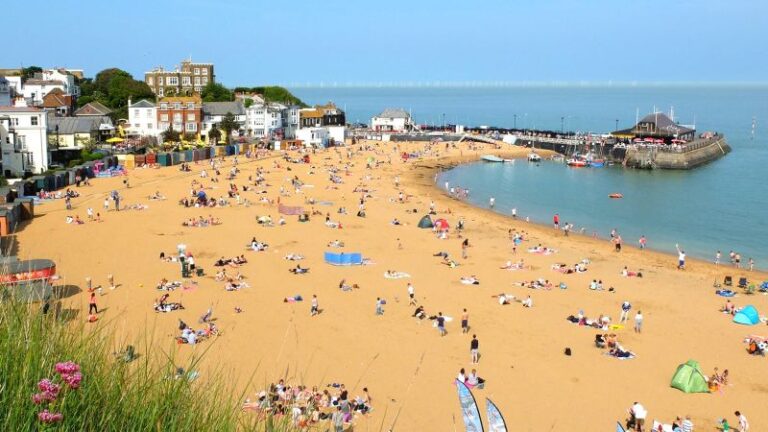Thierry Levenck/Moment Open/Getty Images
The British county of Kent, pictured here at Broadstairs beach, is one of several places around the world considering a tourist tax.
Editor’s note: The views expressed in this commentary are solely those of the author. CNN features work from The Conversation, a collaboration between journalists and academics to provide news analysis and commentary. Content is created exclusively by The Conversation.
CNN —
In April 2024, Venice will begin a controversial experiment to charge day-trippers 5 euros ($5.40) to visit the city on the busiest days of the year. But the lagoon city, which attracts 30 million tourists a year, is not the only one interested in implementing a new tourist tax.
In the UK, Kent county council has proposed introducing a tourist tax on accommodation in the county, while in Scotland visitors to Edinburgh could be forced to pay a fee by 2026, and the Welsh government is due to introduce similar legislation later this year.
More than 60 countries around the world already have these types of taxes, ranging from a national tax in Iceland to various town taxes in the U.S. Some have been around for a long time (France first introduced one in 1910), but most have only been in place for the last 10-20 years.
Before the pandemic hit hard (and tourism was shut down), 2020 was described by one newspaper as “the year of the tourist tax” as Amsterdam joined a growing list of destinations, including Paris, Malta and Cancun, that tax tourists just for visiting.
The introduction of such tourism taxes has often been controversial, with industry groups expressing concern about their potential impact on the tourism industry.
Furthermore, the relationship between these taxes and visitor numbers appears to be complex, with studies coming to different conclusions: some have found, for example, that tourism taxes discourage international tourism in the Balearic Islands and the Maldives, and may discourage domestic tourism participation.
But Barcelona, one of the world’s top tourist destinations subject to the tax, has seen a steady rise in visitor numbers, with hotel nights rising from 7.1 million in 2013 to 9.5 million in 2019.
In fact, the relationship between tourism taxes and tourist flows is very complex and there is no unified view even within the same country. Italy is one of the most studied countries, but even there the results are not consistent.
Another study of three nearby coastal locations in Italy found that tourism taxes reduced tourist flows in only one destination, while a study of the Italian cities of Rome, Florence and Padua found that they were not negatively affected in terms of either domestic or international demand.
Therefore, the impact of tourism taxes on visitor numbers is inconclusive.
But what about other impacts, such as the potential benefits of spending the revenue collected? As part of an ongoing research project, we looked at seven different destinations that have a tourist tax to see how the money collected is spent.
In most places, tourism tax revenues are used to fund marketing and branding, and are invested directly into promoting tourism. Revenues are also often used to fund tourism infrastructure, from public restrooms and walking and biking trails to a multi-billion dollar convention center in Orange County, Florida.
Andrea Merola/Bloomberg/Getty Images
Venice, Italy, is becoming the first city in the world to experiment with charging admission fees to day-trippers, with tickets being checked.
In the Balearic Islands, revenues tend to go towards projects that mitigate the negative impact of tourism on the islands’ environment, culture and society. These include waste management, protection of natural habitats and historical monuments, and social housing.
However, in general, tourist taxes have been implemented successfully in the destinations we studied, and there is little evidence that they discourage tourists from visiting.
Research has also shown that tourists are more likely to accept and pay the tax willingly if the use of the tax is explained to them and it is directly related to enhancing their experience and promoting sustainable tourism.
For many destinations, the main problem is not overnight guests, but day-trippers who exploit local resources but make little financial contribution. For these reasons, the tax might also be used to discourage day-trippers and encourage longer stays instead.
Venice has been at the forefront of this change, and in April 2024, after lengthy discussions between local authorities, residents and business owners, the city began trialing a day-tourist tax (a so-called “access fee”).
Kent may be a little longer before such radical plans become reality: in contrast to Scotland and Wales, there are currently no national plans for a tourist tax in England.
This might be considered short-sighted, given that many English destinations desperately need improvements to the local infrastructure that tourists rely on, such as clean beaches and public transport. In Manchester and Liverpool, businesses voluntarily charge visitors accommodation fees, without any legal basis for implementing a compulsory tax.
It’s likely that many other towns and cities will follow suit, so wherever you visit, you may need to consider budgeting tourist taxes into your future travel plans.
View this interactive content on CNN.com
Source link

